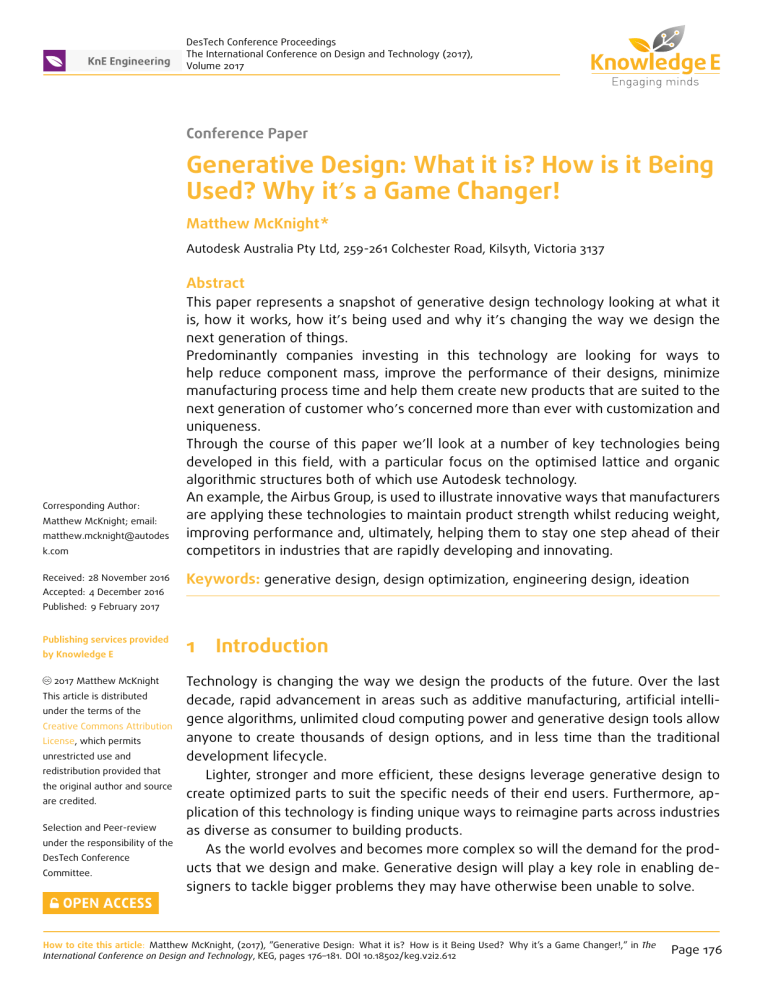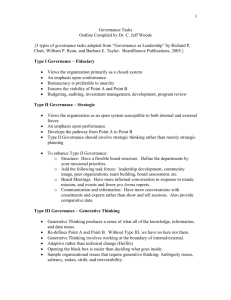
DesTech Conference Proceedings The International Conference on Design and Technology (2017), Volume 2017 Conference Paper Generative Design: What it is? How is it Being Used? Why it’s a Game Changer! Matthew McKnight* Autodesk Australia Pty Ltd, 259-261 Colchester Road, Kilsyth, Victoria 3137 Abstract Corresponding Author: Matthew McKnight; email: matthew.mcknight@autodes k.com Received: 28 November 2016 Accepted: 4 December 2016 This paper represents a snapshot of generative design technology looking at what it is, how it works, how it’s being used and why it’s changing the way we design the next generation of things. Predominantly companies investing in this technology are looking for ways to help reduce component mass, improve the performance of their designs, minimize manufacturing process time and help them create new products that are suited to the next generation of customer who’s concerned more than ever with customization and uniqueness. Through the course of this paper we’ll look at a number of key technologies being developed in this field, with a particular focus on the optimised lattice and organic algorithmic structures both of which use Autodesk technology. An example, the Airbus Group, is used to illustrate innovative ways that manufacturers are applying these technologies to maintain product strength whilst reducing weight, improving performance and, ultimately, helping them to stay one step ahead of their competitors in industries that are rapidly developing and innovating. Keywords: generative design, design optimization, engineering design, ideation Published: 9 February 2017 Publishing services provided by Knowledge E 2017 Matthew McKnight This article is distributed under the terms of the Creative Commons Attribution License, which permits unrestricted use and redistribution provided that the original author and source are credited. Selection and Peer-review under the responsibility of the DesTech Conference Committee. 1 Introduction Technology is changing the way we design the products of the future. Over the last decade, rapid advancement in areas such as additive manufacturing, artificial intelligence algorithms, unlimited cloud computing power and generative design tools allow anyone to create thousands of design options, and in less time than the traditional development lifecycle. Lighter, stronger and more efficient, these designs leverage generative design to create optimized parts to suit the specific needs of their end users. Furthermore, application of this technology is finding unique ways to reimagine parts across industries as diverse as consumer to building products. As the world evolves and becomes more complex so will the demand for the products that we design and make. Generative design will play a key role in enabling designers to tackle bigger problems they may have otherwise been unable to solve. How to cite this article: Matthew McKnight, (2017), ”Generative Design: What it is? How is it Being Used? Why it’s a Game Changer!,” in The International Conference on Design and Technology, KEG, pages 176–181. DOI 10.18502/keg.v2i2.612 Page 176 DesTech Conference Proceedings Figure 1: A VIEW OF THE GENERATIVE DESIGN ALGORITHMS CREATING A CHAIR STRUCTURE. 2 2.1 Methodology Why Generative Design? The typical design process, often referred to as the traditional design process, requires the knowledge and expertise of the designer to craft products that meet the needs of the end user. Often a laborious process, this requires designers and engineers to meticulously understand various principles and processes to adequately generate a final design. Even then, and after many hours of design, analysis and prototyping, the pressures to reduce the development cycle often result in designs that are far from optimal. Combine this with the next generation of products that are emerging, which require ultra-high performance characteristics and are too demanding for the traditional design process, and this is where generative design will help create the optimized designs of the future. With the emergence of technologies such as artificial intelligence algorithms and infinite computing, which are much more accessible that any time in the past, designers and engineers can co-create designs using parameter driven optimization. 2.2 What is Generative Design? Generative design is the process of using algorithms to help explore the variants of a design beyond what is currently possible using the traditional design process. Mimicking natures evolutionary approach, generative design uses parameters and goals to quickly explore thousands of design variants to find the best solution. DOI 10.18502/keg.v2i2.612 Page 177 DesTech Conference Proceedings With each iteration generative design is testing the structure and learning from each step, applying change at each stage to help produce an optimized solution which meets the design goals within the parameters outlined in the study setup. This process often results in designs that would not have otherwise been possible to create using the traditional design process. As the final forms are designed to suit a specific need, they’re shape is unique and often referred to as organic. 2.3 How does it work? As previously discussed, generative design allows for a more integrated workflow between designer/engineer and computer. In effect they both become co-creators of the final design. Though there are various ways generative design can be used the following is a summary of the more typical application of the generative design process: Step 1: This stage requires the expertise of the designer/engineer to establish and input the design parameters and goals. Examples of parameters include material properties (eg. weight, strength and cost), load cases and constraints. It might also include the volume or space in which the final design can occupy. Typical goals include the likes of mass, deflection and stress. Step 2: Using algorithms and its own reasoning, the generative design solution generates 1,000s of designs, potentially running performance analysis for each. This processing might be local or, for more intensive calculations, uploaded for cloud solving. Step 3: On receiving initial results from the generative design solution the designer/engineer will usually study the various options, modifying parameters and goals in an effort to refine the problem. The generative design system will then iterate until, using human intuition and computational artificial intelligence (AI), the most relevant solution is identified. Step 4: With the final design a designer/engineer now has the ability to manufacture the design. This usually requires processes suited to the creation of complex organic geometry typical of this process. In many cases Additive Manufacturing (AM) is the primary form of manufacture. 3 3.1 Results What are some of the more typical results? In general, generatively designed products have the following key characteristics: Reduced Weight: Products designed using generative design can offer a considerable weight saving over that of traditionally designed products. DOI 10.18502/keg.v2i2.612 Page 178 DesTech Conference Proceedings Maintained or improved performance: Whilst reducing weight, generative designed structures are optimized to suit the specific structural requirements of a design. This helps them meet strength and stiffness performance requirements whilst, at the same time, using the least amount of material to do so. Reduce development time: Through the use of infinite computing, 1,000s of design variants can be investigated in the same time it might take to create one design using a more traditional approach. Increased creativity: As a result of creating 1,000s of ideas, designers and engineers can quickly explore the suitability of forms they may not have otherwise imagined or created. Increased efficiency: As simulation and testing can be included as part of the generative design process, this saves designers and engineers time otherwise lost making iterative changes typical of a more traditional design process. Customized product development: Through the use of generative design and additive manufacturing, complex geometry specifically designed and optimized to suit an individual need is much more accessible than ever before. 3.2 How is it used by industry? There are numerous examples of generative design technology being used on commercially available products. These products often support industries as vast as manufacturing, building and even infrastructure. The example below is from the field of manufacturing. Airbus Group: Aircraft manufacturers are under increasing pressure to find ways to make jetliners lighter, more efficient and to leave a smaller carbon footprint. The role of the Emerging Technologies and Concepts group at Airbus is to look at emerging technologies that will play a role in designing and manufacturing the next generation of aircraft. Through the use of generative design, they looked at the practical application of this technology on an existing A320 partition, a component that separates the passenger compartment from the galley. The design requirements included reducing the weight of the component, structurally support the loads of flight attendants during takeoff and landing and attaching to the plane in four (4) locations. Using generative design algorithms based on that of slime mold, a single celled organism, the Airbus designers and engineers were able to apply design parameters (including materials, loads and constraints) and have the generative design application, in this case Autodesk Within, cycle through thousands of different design variants before settling on an optimal design. DOI 10.18502/keg.v2i2.612 Page 179 DesTech Conference Proceedings Figure 2: MECHANICAL CHARACTERISTICS OF A CHAIR DESIGNED USING GENERATIVE DESIGN. The final structure, which was based on mammal bones, resulted in a design that is 45% lighter than the previous design. Manufactured using additive manufacturing the product requires 95% less raw material in comparison t0 one created using traditional processes. It’s estimated that approximately 3,180 kg of fuel can be saved per partition, per year. The partition is undergoing final testing and approval. Once complete the final design could be used in A320 aircraft as soon as 2018. 4 Summary and Conclusion Generative design is quickly changing the way that manufacturers create the next generation of products. The expectation for products to perform better and weigh less than previous designs is one aspect of this. Another is for new designs that offer their customer uniqueness and customization that leverage the new ways of making things. And this technology is more accessible than ever before, giving designers affordable access to powerful cloud computing and artificial algorithms that help quickly and efficiently create thousands of designs in less time than it would take using a more traditional approach. Companies such as the Airbus Group are using generative design technology to create optimized structures that help reduce the weight of structural components yet at the same time maintaining aircraft safety requirements. DOI 10.18502/keg.v2i2.612 Page 180 DesTech Conference Proceedings Future versions of generatively designed products will be connected, measuring information and then using this to help drive the algorithms and further improve the effectiveness of this technology. And combined with new methods of manufacturing, in particular additive manufacturing, this technology will provide opportunities to disrupt traditional markets enabling them to create ultra-high performing products that traditional design and manufacturing technologies cannot replicate. The future is more exciting than ever before as these new technologies become a more integral part of the new design process. References https://autodeskresearch.com/projects/dreamcatcher. http://www.airbusgroup.com/int/en/story-overview/Pioneering-bionic-3D-printing.html. http://www.autodesk.com/products/within/overview. https://redshift.autodesk.com/what-is-generative-design-2/. DOI 10.18502/keg.v2i2.612 Page 181



